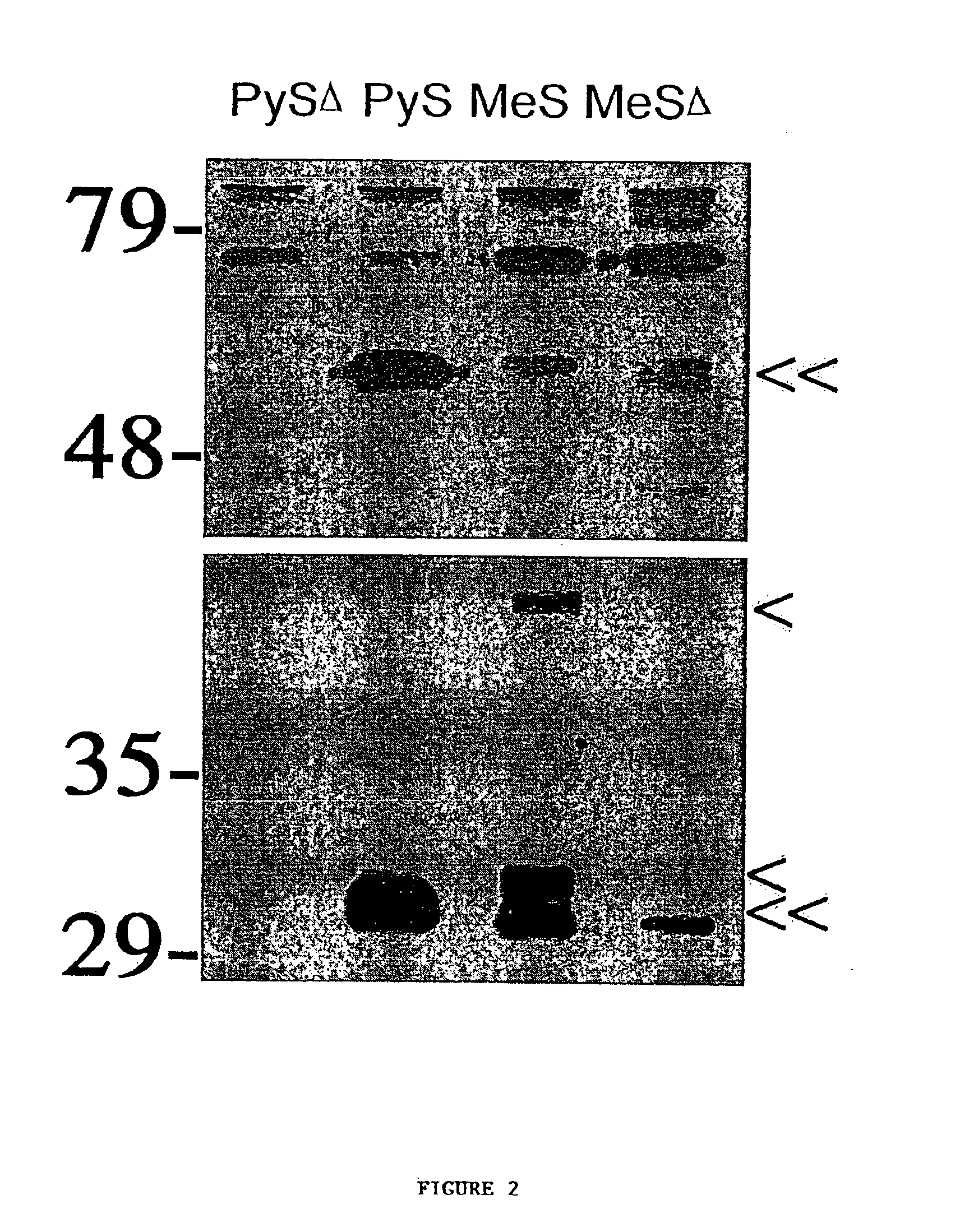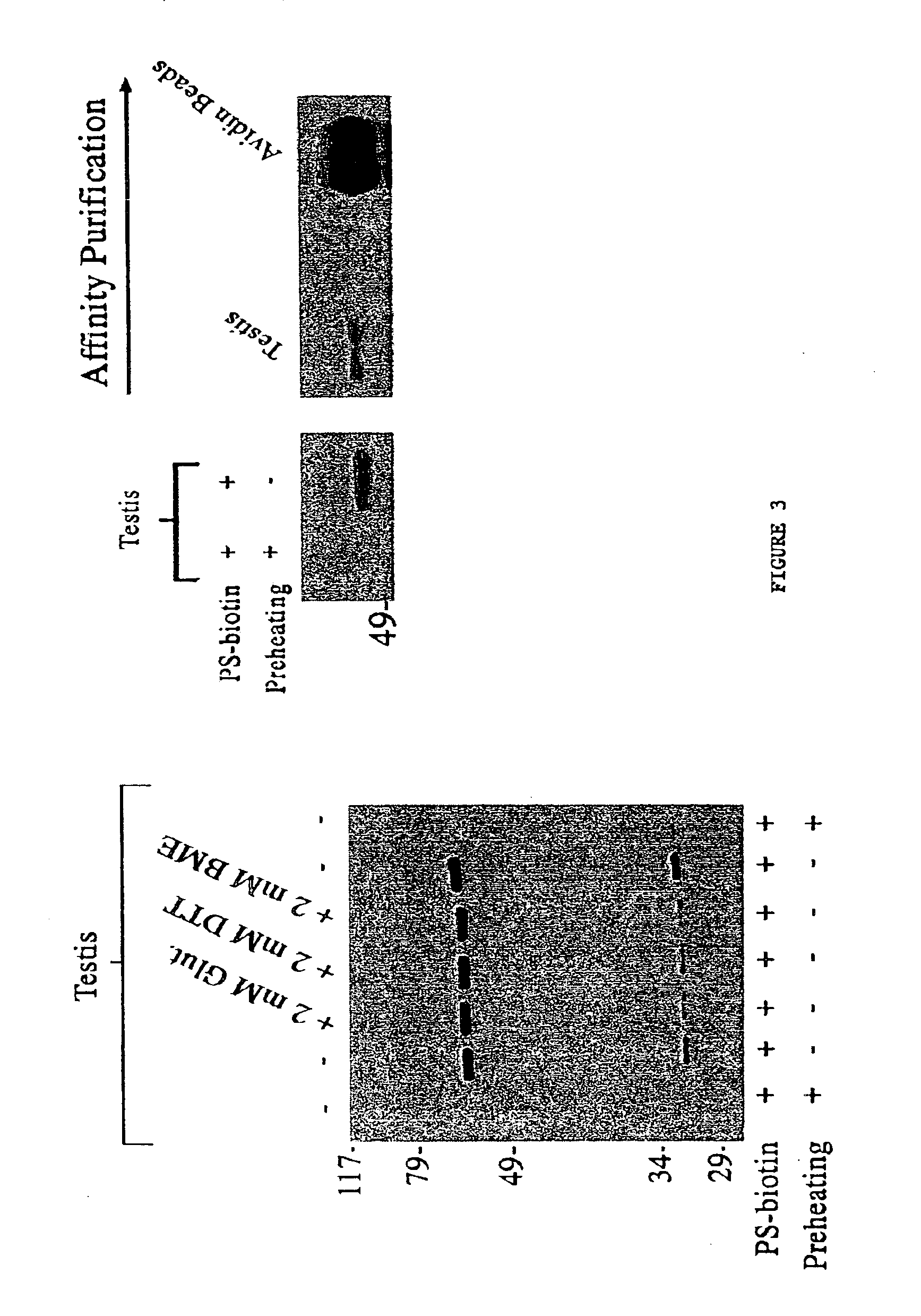Proteomic analysis
a proteome and proteome technology, applied in the field of proteome analysis, can solve the problems of insufficient knowledge of the genome sequence to explain biology and understand disease, methods that do not describe selectively detecting active versus inactive proteins within a sample, and methods that fail to report on enzyme activity
- Summary
- Abstract
- Description
- Claims
- Application Information
AI Technical Summary
Benefits of technology
Problems solved by technology
Method used
Image
Examples
example 1
Compound 1 is the starting material tetraethyleneoxy (3,6,9-oxa-1,11-diolundecane) as depicted in the flow chart in FIG. 8.
Compound 2. A solution of 1 (3.9 g, 20.0 mmol, 3.0 equiv) in DMF (8.0 mL) was treated with TBDMSCl (1.0 g, 6.64 mmol, 1.0 equiv) and imidazole (0.9 g, 13.3 mmol, 2.0 equiv) and the reaction mixture was stirred for 12 h at room temperature. The reaction mixture was then quenched with saturated aqueous NaHCO3 and partitioned between ethyl acetate (200 mL) and water (200 mL). The organic layer was washed with dried (Na2SO4) and concentrated under reduced pressure. Chromatography (SiO2, 5×15 cm, 50-100% ethyl acetate-hexanes) afforded 2 (1.1 g, 2.0 g theoretical, 55%) as a colorless oil: 1H NMR (CDCl3, 400 MHz) δ 3.8-3.5 (m, 16H, CH2OR), 0.88 (s, 9H, CH3C), 0.0 (s, 6H, CH3Si).
Compound 3. A solution of 2 (0.61 g, 2.0 mmol, 1.0 equiv) in benzene (15 mL, 0.13 M) was treated sequentially with PPh3 (2.6 g, 10.0 mmol, 5 equiv), 12 (2.3 g, 9.0 mmol, 4.5 equiv), and imidazo...
example 2
Preparation of FP-biotin
FP-Biotin was prepared as described by Liu et al. (Proc. Natl. Acad. Sci. 96(26):14694, 1999) and in U.S. Ser. Nos. 60 / 195,954 and 60 / 212,891, herein incorporated by reference in their entirety. 1-Iodo-10-undecene (3). A solution of 2 (3.4 g, 10.5 mmol, 1.0 equiv) in acetone (21 mL, 0.5 M) was treated with NaI (3.2 g, 21 mmol, 2.0 equiv) and the reaction mixture was stirred at reflux for 2 h, producing a yellow-orange solution. The reaction mixture was then partitioned between ethyl acetate (200 mL) and water (200 mL). The organic layer was washed sequentially with saturated aqueous Na2S2O3 (100 mL) and saturated aqueous NaCl (100 mL), dried (Na2SO4), and concentrated under reduced pressure. Chromatography (SiO2, 5×15 cm, 1-2% ethyl acetate-hexanes) afforded 3 (2.3 g, 2.9 g theoretical, 78%) as a colorless oil: 1H NMR (CDCl3, 250 MHz) δ 5.95-5.75 (m, 1H, RCH═CH2), 5.03-4.90 (m, 2H, RCH═CH2), 3.16 (t, J=7.0 Hz, 2H, CH2I), 2.02 (m, 2H, CH2CH═CH2), 1.80 (p, J=6....
example 3
Molecular Characterization of FP-biotin Reactive Proteins
Brain soluble extracts were run over a Q sepharose column using an ÄKTA FPLC (Amersham Pharmacia Biotech) and eluted with a linear gradient of 0-500 mM NaCl. Samples of the elution fractions (10×2.5 mL fractions) were labeled with FP-biotin as described above, and those fractions containing the 75 kDa and 85 kDa labeled proteins were pooled and passed over a Mono-Q sepharose column. Proteins were eluted from the Mono-Q column with a linear gradient of 200-500 mM NaCl and those elution fractions enriched in the two labeled proteins were then run on SDS-PAGE and transferred to polyvinylidine difluoride (PVDF) membranes by electroblotting. Regions of the PVDF membranes containing the 75 and 85 kDa FP-biotin reactive proteins were excised, digested with trypsin, and the resulting peptides analyzed by matrix-assisted laser desorption ionization (MALDI) and MALDI-post-source decay time-of-flight mass spectrometry (Chaurand, et al. (...
PUM
| Property | Measurement | Unit |
|---|---|---|
| Fraction | aaaaa | aaaaa |
| Fraction | aaaaa | aaaaa |
| Fraction | aaaaa | aaaaa |
Abstract
Description
Claims
Application Information
 Login to View More
Login to View More - R&D
- Intellectual Property
- Life Sciences
- Materials
- Tech Scout
- Unparalleled Data Quality
- Higher Quality Content
- 60% Fewer Hallucinations
Browse by: Latest US Patents, China's latest patents, Technical Efficacy Thesaurus, Application Domain, Technology Topic, Popular Technical Reports.
© 2025 PatSnap. All rights reserved.Legal|Privacy policy|Modern Slavery Act Transparency Statement|Sitemap|About US| Contact US: help@patsnap.com



